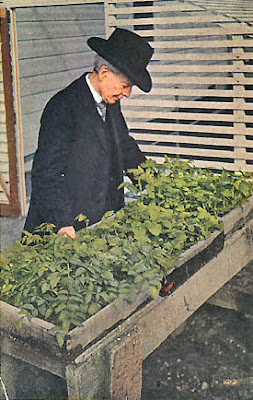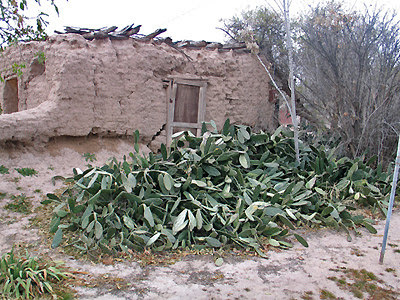Spineless Cactus
If you look around many of the older homes in the Mesilla Valley, you'll see an odd-looking prickly pear. It's thornless.

Alien mutation?
Nope -- the non-prickly prickly pear is the creation of the eclectic Luther Burbank, "The Plant Wizard."
Burbank was born in 1849 and had no schooling beyond 6th grade, but he did have an intense fascination with plant breeding. He is credited with creating over 800 strains and varieties of plants, including the "impossible" plumcot, which he called "a cross which man said could never be made."
The 12 volumes of his 1914 magnum opus, "Luther Burbank: His Methods and Discoveries and Their Practical Application" is available online, includes wonderful color photos, and still makes interesting and enjoyable reading. His self-promotion, however, sometimes leads him to sound like a cross between a used car salesman and P. T. Barnum.
He began developing a spineless cactus in the late 1800s with the goal of producing a plant that could grow in the desert and serve as food for livestock.
He says of this effort, "the work through which this result was achieved constituted in some respects the most arduous and soul-testing experience that I have ever undergone."
Here's a picture from the book showing Burbank examining cactus seedlings:

It may look like a loving relationship, but...
The spines on the prickly pear (and other cacti) evolved from leaves on its ancestral parent. These leaves, over time, became sharp spines and acquired the capacity to detach easily when touched, a very effective defense against being eaten.
What Burbank succeeded in doing with his selection and cross-breeding was to produce a plant that grew only rudimentary spines and then dropped them voluntarily. In this photo from his book you can see the vestigial leaves with the spines gone.

Burbank's hopes for millions of acres of desert growing spineless cactus as animal feed was never realized, but for a while the un-prickly pear was quite popular as a landscape plant around homes in arid areas like Southern New Mexico.
Here's a planting around an old Adobe home in Mesilla:

A planting in Las Cruces:

A planting in Organ:

A planting next to an abandoned, decaying Adobe in Doña Ana:

A cactus without spines is defenseless. The photo below was taken about 2 months after the one above:

Someone, in an act of pure vandalism, has stomped the plant.
Tags: Spineless Cactus, Luther Burbank, History, Adobe

Alien mutation?
Nope -- the non-prickly prickly pear is the creation of the eclectic Luther Burbank, "The Plant Wizard."
Burbank was born in 1849 and had no schooling beyond 6th grade, but he did have an intense fascination with plant breeding. He is credited with creating over 800 strains and varieties of plants, including the "impossible" plumcot, which he called "a cross which man said could never be made."
The 12 volumes of his 1914 magnum opus, "Luther Burbank: His Methods and Discoveries and Their Practical Application" is available online, includes wonderful color photos, and still makes interesting and enjoyable reading. His self-promotion, however, sometimes leads him to sound like a cross between a used car salesman and P. T. Barnum.
He began developing a spineless cactus in the late 1800s with the goal of producing a plant that could grow in the desert and serve as food for livestock.
He says of this effort, "the work through which this result was achieved constituted in some respects the most arduous and soul-testing experience that I have ever undergone."
Here's a picture from the book showing Burbank examining cactus seedlings:

It may look like a loving relationship, but...
"For five years or more the cactus blooming season was a period of torment to me both day and night. Time and again I have declared from the bottom of my heart that I wished I had never touched the cactus to attempt to remove its spines. Looking back on the experience now, I feel that I would not have courage to renew the experiments were it necessary to go through the same ordeal again.
Not only would the little spicules find lodgement everywhere in my skin, but my clothing became filled with them, and the little barbs would gradually work their way through the cloth and into my flesh, causing intense irritation."
The spines on the prickly pear (and other cacti) evolved from leaves on its ancestral parent. These leaves, over time, became sharp spines and acquired the capacity to detach easily when touched, a very effective defense against being eaten.
What Burbank succeeded in doing with his selection and cross-breeding was to produce a plant that grew only rudimentary spines and then dropped them voluntarily. In this photo from his book you can see the vestigial leaves with the spines gone.

Burbank's hopes for millions of acres of desert growing spineless cactus as animal feed was never realized, but for a while the un-prickly pear was quite popular as a landscape plant around homes in arid areas like Southern New Mexico.
Here's a planting around an old Adobe home in Mesilla:

A planting in Las Cruces:

A planting in Organ:

A planting next to an abandoned, decaying Adobe in Doña Ana:

A cactus without spines is defenseless. The photo below was taken about 2 months after the one above:

Someone, in an act of pure vandalism, has stomped the plant.
Tags: Spineless Cactus, Luther Burbank, History, Adobe
Labels: Adobe, History, Luther Burbank, Spineless Cactus


0 Comments:
Post a Comment
<< Home